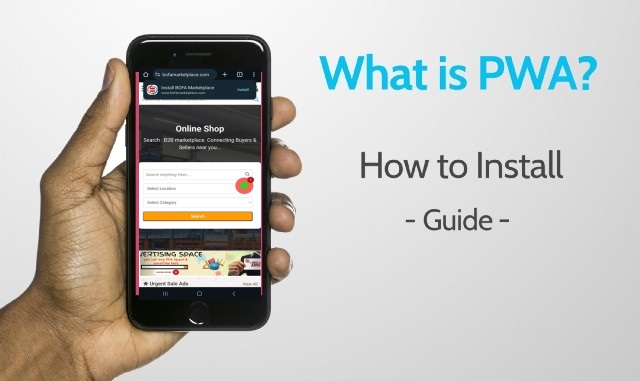26-11-2023 00:25:01

1. How to Install BOFA Marketplace PWA app on Android and IOS
BOFA Marketplac is develop with Progressive Web Apps (PWA) Technology. An hybrid web pages which can be downloaded to your device just like a native APP and are designed to mimic native APP user experiences.
Once a user Installs or Adds it to your Home Page — PWA’s behave just like APPs.
While the number of mobile users is growing each day — slow connections are an everyday problem for many and result in a frustrating user experiences. PWA’s are a great solution thanks to faster loading speeds and since they can even work while offline.
Here at Nigeria, we have a global user base and with some of our users yet to have access to 4G, let alone 5G networks. That’s why we chose PWA over a native app on iOS and Android and makes for an excellent solution for our BETA product.
2. How to install BOFA Marketplace as App on your iPhone or Android?
How to install BOFA Marketplace as app to iphone/iOS device via Safari.
1️⃣ Open Safari on your iPhone
2️⃣Go to the website https://www.bofamarketplace.com
3️⃣Tap the Share button on Safari
4️⃣Find by slide to the right “Add to Home Screen.”
5️⃣Tap it, then tap Add (top right)
How to install BOFA Marketplace as app to Android device via Chrome.
Android
1️⃣Open Chrome on your Android Mobile Device
2️⃣Go to the website https://www.bofamarketplace.com
NOTE: As soon as the website display, a pup-up will appear propting user to install BOFA Marketplace
ELSE:
3️⃣Tap Settings (Top right corner) on Chrome
4️⃣Slide down and tap “ install or Add to Home Screen.”
Advantages of PWA Technology on BOFA Marketplace and Online Shop Platform
Progressive Web Apps (PWAs) offer several advantages that contribute to a better user experience, increased engagement, and improved performance. Here are some key advantages of Progressive Web Apps:
-
Cross-Platform Compatibility:
- PWAs work across different platforms and devices, providing a consistent experience on desktops, tablets, and smartphones. This reduces the need for platform-specific development.
-
Responsive Design:
- PWAs are built with responsive design principles, ensuring that the application adapts seamlessly to various screen sizes and orientations.
-
Offline Functionality:
- One of the standout features of PWAs is their ability to work offline or in low-network conditions. They can cache content and functionality, allowing users to access certain features even without an internet connection.
-
Improved Performance:
- PWAs leverage modern web technologies to deliver faster loading times and smoother interactions, enhancing the overall performance compared to traditional web applications.
-
App-Like Experience:
- PWAs provide an app-like experience with features such as home screen icons, immersive full-screen mode, and smooth animations, making them feel like native applications.
-
Discoverability and Shareability:
- PWAs are discoverable through search engines, and users can share them easily via URLs. This makes it simpler for users to find and share content.
-
No Installation Required:
- Unlike native apps, PWAs do not require installation from an app store. Users can access the app directly through a web browser, eliminating the friction associated with app downloads.
-
Automatic Updates:
- PWAs can be d automatically, ensuring that users always have access to the latest features and improvements without requiring manual s.
-
Reduced Data Usage:
- PWAs are designed to be efficient with data usage, which is particularly beneficial in regions with limited or expensive data plans.
-
Increased Engagement:
- Features like push notifications help increase user engagement by allowing businesses to re-engage users with timely and personalized messages.
-
Security:
- PWAs use HTTPS to ensure secure communication between the user's device and the server, providing a more secure browsing experience.
-
Cost-Effectiveness:
- Developing a single PWA that works across platforms can be more cost-effective than building and maintaining separate native apps for each platform.
-
Accessibility:
- PWAs can be designed to be accessible to users with disabilities, providing a more inclusive experience.
-
Progressive Enhancement:
- PWAs follow the principle of progressive enhancement, meaning they can still deliver a basic experience to users with older browsers while providing enhanced features to users with more modern browsers.
These advantages make PWAs an appealing choice for businesses and developers looking to provide a reliable, engaging, and performant user experience on the web.
